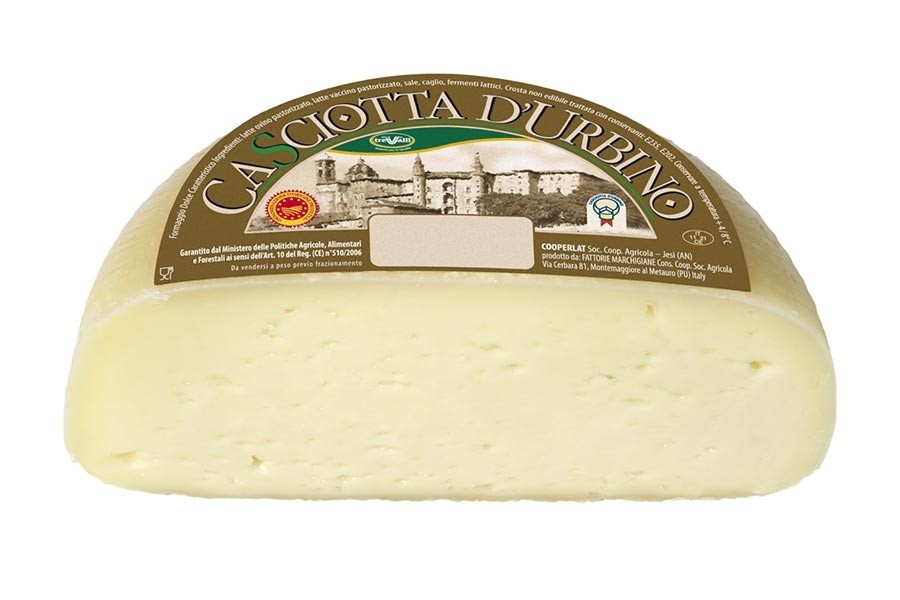Casciotta of Urbino Cheese P.D.O.
Product description
Casciotta d’Urbino PDO is a semi-cooked cheese produced with 70-80% whole sheep’s milk and 20-30% cow’s milk drawn from daily milkings within the production area.
Production method
The milk is curdled with animal rennet at 35 - 38°C. Once the curd has reached the right consistency, it is broken into grains the size of hazelnuts;
it is then placed under pressure for several hours in molds that promote moisture loss. The next processing stage is salting, which is done manually and is generally dry salting, at times alternating with immersion in brine.
Ripening takes place in an environment with a temperature of 10-14°C and a humidity level of 80-90%, depending on the dimension of the round; it can last between 20-30 days, producing a fresh or more mature cheese.
In order to avoid the growth of mould, part of the Casciotta d’Urbino PDO round is covered with a transparent and shiny wax that protects the rind.
Apparence and flavour
Casciotta d’Urbino PDO has a thin straw yellow coloured rind when it is fully mature.
It has a height of 5 to 7 cm and a diameter of 12 to 16 cm. The off-white coloured cheese is moist and crumbly, with a few eyes.
Its flavour is sweet and persistent, characteristic of the production method.
Gastronomy
Casciotta d’Urbino PDO should be conserved at a temperature of between 4-8°C, therefore on the least cold shelf if placed in the fridge.
It is advisable to bring it to room temperature before eating in order to appreciate its particular flavour.
It is an extremely versatile cheese and is used in various dishes, from starters to delicate pasta dishes.
It is often eaten together with the typical “Crescia Sfogliata di Urbino”, a simple yet refined traditional recipe.
If particularly fresh, it is indicated for creams and sauces; the more mature variety is used for stuffings and fillings.
It can even be served as a main dish, together with an assortment of complementary ingredients.
Casciotta d’Urbino PDO is generally paired with light wines; stronger flavoured first and second courses should be paired with medium-full bodied wines.
At the end of a meal, it is ideal to serve with caramelized fruit or sweets and can be paired with sweet wines.
Marketing
The product is marketed as Casciotta d’Urbino PDO. It is sold fresh or mature, whole, in large pieces and in pre-packed slices.
Distinctive features
Casciotta d’Urbino PDO gets its particular flavour from the local mountain herbs that constitute the diet of the cows and sheep.
History
The name Casciotta derives from cascio, a territorial linguistic variation of cacio. This cheese has ancient origins and was already being produced in the XV century.
In fact, the dukes of Montefeltro and Della Rovere dedicated particular attention to dairy production (as indicated by the numerous regulations sited in the Urbino Constitution),
using it as an object of trade with Rome and the Papal State. During this time, Casciotta d’Urbino was often served at large banquets and noble weddings.
According to tradition, it is said that even Michelangelo greatly appreciated this cheese, especially the unripened variety.
Furthermore, in 1761, Cardinal Manganelli, future Pope Clemente XIV, wrote a letter from Rome, thanking Abbot Antonio Tocci di Cagli for having sent him delicious casciotte.
Prosuction area
The production area of Casciotta d’Urbino PDO is within the provinces of Pesaro and Urbino, in The Marches region.
Operators: 47
Production(KG): 229.862
Turnover(MLN€): 2,01

 IT
IT 